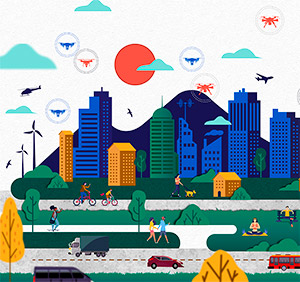Jun 1 2020
The main aim of Bubbles, a European research project led by the Universitat Politècnica de València (UPV), is to guarantee the secure integration of drones in the airspace.
It has grown rapidly, and it is expected that it will continue to do so in the coming years. Parcel delivery, public safety and entertainment are just a few of its potential uses. There are going to be more and more drones and their economic impact is going to be very high, but it is necessary to guarantee their safe integration into airspace.
Juan Vicente Balbastre, Professor and Researcher, Institute of Information and Communication Technologies, Universitat Politècnica de València
Balbastre, who is also a coordinator of the project, explained the above about the use of unmanned aerial systems (UAS) such as drones.
U-Space Benefits and Risks
 Image Credit: Universitat Politechica de Valencia
Image Credit: Universitat Politechica de Valencia
The use of UAS involves certain risks, particularly in regions that are densely populated, whether terrestrial, with incidents or accidents, in which surface vehicles, UAS, people, infrastructure, and/or buildings may be involved; or air, associated with collisions between manned aircraft and UAS.
Also, there are threats to privacy, which may occur due to the misuse of data gathered by the aircraft, and safety risks—terrorists transporting explosives, cyber-attacks, etc.
Although the benefits of using UAS are much greater than the risks. it is necessary to face the latter so that the former can be fully achieved. For this, the European Commission, through SESAR JU, proposes the design of a set of new services, based on a high level of digitization and automation of functions and specific procedures, aimed at supporting safe and efficient access to space large amounts of UAS, which is known as the U-Space.
Juan Vicente Balbastre, Professor and Researcher, Institute of Information and Communication Technologies, Universitat Politècnica de València
Safety Bubbles
Bubbles’ main aim is the generation of a new sophisticated service for the management of aircraft isolation in U-Space, which targets complicated operations in regions with heavy traffic.
This service will define “safety bubbles” around UAS and develop processes to inhibit such bubbles from coming into contact with each other.
To develop and verify the idea of this sophisticated separation management service at U-Space, Bubbles will determine the fundamental elements from which it will be constructed, determining how to assemble and make them function.
The UPV researcher denotes, “Bubbles will develop algorithms to calculate the risk of collision of unmanned aerial systems, taking into account all the sources of risk involved, which will allow establishing minimums and separation methods so that a level can be maintained safety defined in terms of overall probability of collision.”
In the same way, Bubbles “will also investigate the application of artificial intelligence (AI) to support separation management, both for centralized and distributed systems,” Balbastre.
In addition, it will contribute to the standardization of U-Space by writing the performance specifications required for CNS systems (Communications, Navigation and Surveillance) based on AI and involved in the provision of the Separation Management service.
Juan Vicente Balbastre, Professor and Researcher, Institute of Information and Communication Technologies, Universitat Politècnica de València
From UPV, scientists from the Institute of Industrial Automation and Informatics (ai2) and the Department of Cartographic Engineering, Geodesy and Photogrammetry also took part in the project.
2.5 Years of Project and 1.6 Million Euros of Funding
The project was financially supported by the European Union through Horizon 2020 and SESAR JU with over 1.6 million euros. The study commenced in May 2020 and will run until the end of 2022.
Under the guidance of UPV, Bubbles also involves the University of Coimbra, the Università degli Studi di Roma La Sapienza, the European Organization for the Safety of Air Navigation (EUROCONTROL) and Indra, the world’s leading company in air traffic management.